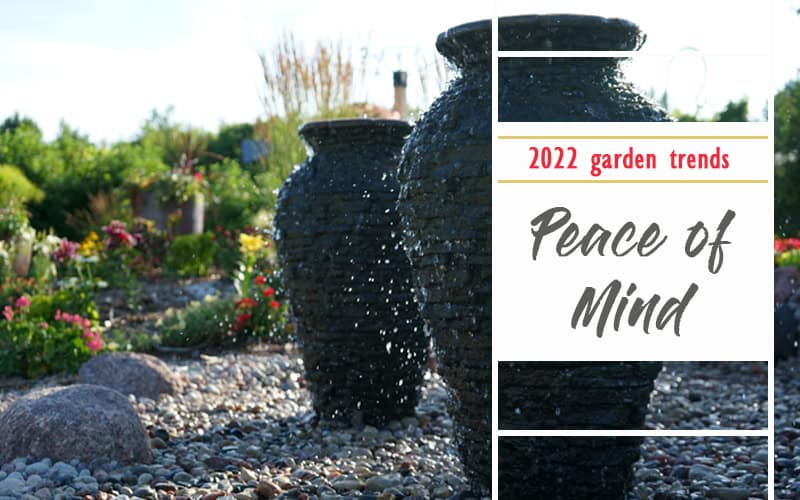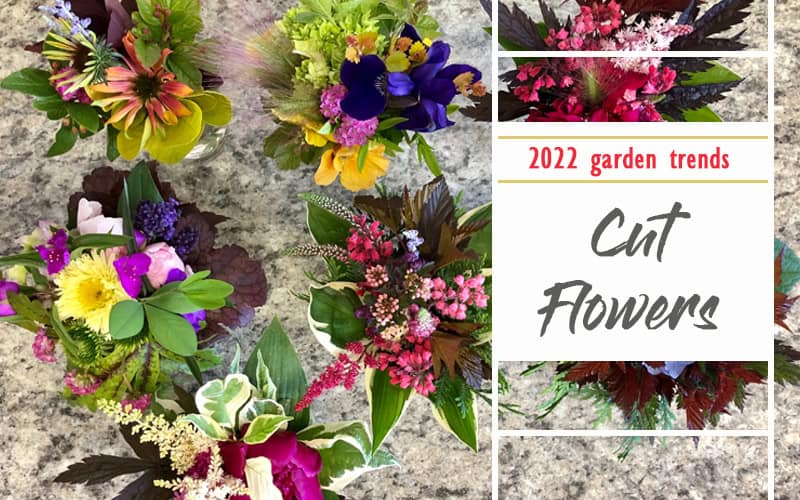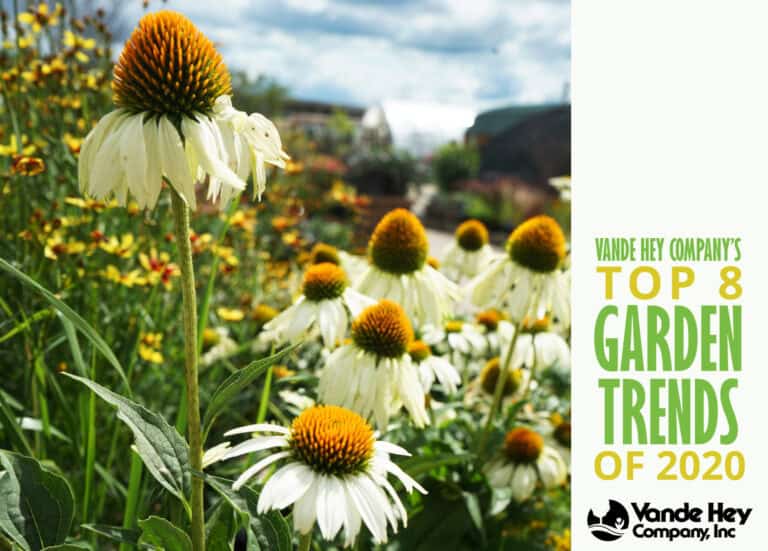7 Garden Trends for 2022
By Kelly Smith | February 9, 2022

The sun is warming, the birds are singing, and each day is a step closer to the long-awaited spring! If you’re already planning out your vegetable garden, dreaming of bright bursts of colorful annuals, and eager to get your hands back in the soil, you aren’t alone. Now is the perfect time for planning, though, and we’re here to get you started with our 7 top trends for the 2022 season!

- Supporting Wildlife and Pollinators
There’s been much justified “buzz” about pollinators recently, but “wildlife friendly” gardening encompasses a wider spectrum, including native birds, fascinating creatures like frogs and newts, and even the overall soil health of your land. Enhancing your landscape to provide food sources and shelter for local species, while caring for the long-term health of your soil and vegetation, opens our minds to the concept of creating and caring for our landscape as a whole entity.
- Include a diverse mix of native plants to conserve water, provide food sources and shelter for animal species, and provide longevity in your garden design.
- Include water features or shallow ponds in your landscape. These provide clean water for a variety of insects and animals, give shelter for breeding and nesting, and benefit your yard by attracting dragonflies, which feed on mosquitoes. As a bonus, they create a relaxing and calming atmosphere!
- Consider using hedges as a divider, rather than fences. Hedges are a great food and shelter source for birds and other creatures, especially during the winter months.
- If you’re short on space, incorporate flowering climbing plants or hanging baskets into your yard space. They’re excellent sources of nectar for pollinators, and provide shelter space for bees, butterflies, and birds.

2. Porch and Balcony Gardening
Many of us have limited yard space or live in apartment buildings. Luckily, gardening doesn’t have to be a hobby only enjoyed by those with vast yards! With a little planning, you can create a gorgeous and functional porch or balcony garden. Here’s how:
- Incorporate hanging baskets or planter boxes on porch railings in areas of limited square footage. Herbs and annuals are very successful in these types of containers – just make sure you’re watering enough (daily, especially in sunny locations).
- Use large pots for mixed plantings. Using a colorful mix of annuals draws attention to your space and creates a beautiful statement piece. Most herbs will also thrive when planted together in a large container. Just be careful with types like mint, dill, and oregano, which can be fast growers and take over the other plants (you can still incorporate them in the planter – just make sure you’re trimming often!).
- Using a large container, mix your ornamental annuals with culinary herbs! The result will be a beautiful mix of color and texture, with the added bonus of delightful aroma.
- Use shelving on your balcony or patio to house small herbs, annuals, or your houseplants in summer. This can create an attractive and interesting focal point for your space and give you ample room for housing plant life!
- Be sure to continually fertilize your planters throughout the season.

3. Tropical Plants
In a world where travel plans and costs are quite unreliable or restricted, many people are choosing to create their own tropical paradises at home! Tropical plants have soared in popularity, and there is a wealth of bold, beautiful colors to choose from.
- Make sure nighttime temperatures are consistently above 50-55 degrees before placing tropical plants outdoors. Also, don’t place them in the direct sun immediately. They’ll need to be acclimated gradually (over the course of 1-2 weeks) or their foliage will scorch, just like our skin!
- A few of our favorite tropicals to incorporate are: Mandevilla, Caladium, Rose of Sharon, Rose Mallow and Cannas. They’ll bring a gorgeous burst of tropical color to your patio!
- Use large-leaf foliage in your tropical arrangements to contrast bright-flowering blooms.
- Use tropical-colored accents in your decor to enhance your design, like orange furniture cushions, bright pink pillows, or turquoise containers.
- Use hardy perennials in your beds that will accent the tropical plantings on your patio. Try incorporating bright Hosta, Iris, or Daylily perennials to compliment your tropical plants.

4. Dark Foliage
Nothing brings depth and contrast to an arrangement or flower bed like a richly colored, dark foliage. Whether you’re making bright annuals and flowering perennials pop or creating an interesting palette of textures, dark foliage can bring an incomparably luscious depth to your design. Try pairing a dark leaf alongside chartreuse or silver foliage or placing it as a backdrop to a vibrant pink, orange or yellow bloom. Here are a few of our favorite deep, dark foliage choices to try out!
- Heuchera, a perennial (also known as Coral Bells)
- Ninebark, a perennial shrub (Try “Tiny Wine”, with deep purple foliage and a delicate, showy white flower)
- Weigela, a perennial shrub (Try “Spilled Wine” or “Minor Black” for dark foliage contrasting with a vibrant pink flower)
- Sweet Potato Vine, an annual (a perfect trailing element in arrangements)
- Purple Basil, an annual herb (has a delicious, slightly spicy flavor in dishes)

5. Gardening for Peace of Mind
In a time of uncertainty, many of us have taken to exploring and developing calming hobbies, unplugging from the digital world, and spending more time outdoors. It comes as no surprise, then, that our own backyards have become our havens and place of peace. If you find yourself drawn to this concept, but are unsure of design elements to include or, even, where to start, here are a few ideas to get the gears turning:
- Begin with intentional elements. Focus on a color that brings you joy, aromas that are pleasing or relaxing to you, or even plants that have a sentimental value to them. This could be a certain rose that grew at your grandmother’s house, or a small vegetable garden that you can enjoy with your children.
- Incorporate elements that appeal to each of your senses. Choose colors you enjoy seeing, or herbs and flowers that bring a pleasant aroma. Consider a water feature, gentle wind chime, or even long grasses that can create a gentle, peaceful sound. Herbs, vegetables, and edible flowers that can be picked and nibbled on can be wonderfully rewarding. And finally, focus on textures, such as edging walkways with soft plants that gently brush against you as you walk through.
- Think about what brings you peace and what you enjoy. Rather than concerning yourself with what is trendy in the design world, find what speaks to you!

6. Cut Flower Gardening
There’s nothing quite as welcoming as a beautiful arrangement of flowers on your table or mantle. But purchasing fresh bouquets from a local market or store isn’t always cost effective or convenient. If you find yourself loving the ambiance cut flowers bring to your home, consider incorporating them into your landscape! Planning a cut flower garden is a simple task to take on, and one that will reward you all season long.
- First, pick a location with lots of sun and well-draining soil. Don’t worry if you don’t have room for a dedicated cut flower bed; annual or bulb flowers can be incorporated just about anywhere: in planters, in your vegetable garden, or between perennials and shrubs.
- Plant flowers with the tallest in the back and shortest in the front. Be sure to include a trellis for trailing plants like nasturtium.
- Mulch in your plants to help retain moisture; plants that stay well-watered in healthy soil will produce bigger, better blooms. Be sure to remove spent flowers and foliage to encourage the best new growth and blooms, too, and fertilize regularly.
- A few of our favorites to include in a cut flower garden are Zinnia, Dahlia, Poppy, Alstromeria, Lavender, Sunflower, Celosia, Phlox, Artemesia, and Coleus.

7. Bringing the Outdoors In…. and the Indoors Out
You’ve probably heard of this concept attributed to Frank Lloyd Wright and, if you’re not incorporating it into your home design, now is the time to implement it! The positive response to nature and our drive to connect with it, known as biophilia, has firmly rooted itself in the design world. Take this concept a step further, though, and consider bringing the “indoors out” to bring comfort and convenience to your outdoor space, too!
Bringing the Outdoors In:
- Plant an herb garden and keep it on a sunny window ledge.
- Use grow lights in dark rooms to help indoor plant life thrive.
- Plant your outdoor plants where they can be seen from inside. Or place hanging planters and trellises near windows, so they can be enjoyed from inside, too.
Bringing the Indoors Out:
- Use outdoor lighting to extend your evening patio hours and create a cozy atmosphere.
- Incorporate fire features into your design for cool evenings and a comforting ambiance.
- Create a “garden room” – this could be a dedicated nook for reading and enjoying a glass of wine, or a full dining area for entertaining guests. Depending on your intent, focus on the details needed to enhance the space; for example, a dining area could entail a great grill, large table, beverage refrigerator, shade feature, and countertop space.
- Naturally screen or outline areas with hedges or hanging plants.
As always, our team of dedicated horticulturists, designers, and gardening specialists are here to help you with any questions or concerns you may have. Reach out to us at 920.788.6344 or stop in to our garden center.
Whether you’re just starting your landscaping hobbies, a first time home owner, or an avid, lifelong gardener…. we wish you a happy and bountiful 2022 season and look forward to seeing you!



